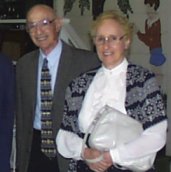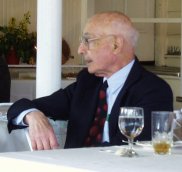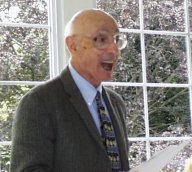
Dr.
Lester Machta, former director of the
NOAA Air Resources Laboratory, died on August
31, 2001, at age 82, of leukemia at Georgetown
University Hospital in Washington, DC. Dr.
Machta will be remembered as a visionary scientist
and manager who led scientific research efforts
on some of the key environmental issues of
the 20th century.
In 1948,
Dr. Harry Wexler, Director of Research of the U.S.
Weather Bureau, selected Dr. Machta to head the
Special Projects Section in Washington DC, whose
purpose was to address meteorological and environmental
aspects of post-war nuclear activities. He served
as director of that group, and of its successor
organization, the NOAA Air Resources Laboratory,
until 1990, and continued working at the laboratory
until the time of his death.
 In
the 1950's Dr. Machta led efforts to understand
the transport and dispersion of radioactivity in
the atmosphere. The Special Projects Section provided
meteorological forecasts in support of U.S. atomic
bomb tests, assessed the potential exposure of
U.S. citizens to radioactive fallout both from
hypothetical foreign attacks and from testing,
detected secret Soviet bomb tests using back trajectory
methods, and provided key scientific input to international
nuclear test ban treaty negotiations. In
the 1950's Dr. Machta led efforts to understand
the transport and dispersion of radioactivity in
the atmosphere. The Special Projects Section provided
meteorological forecasts in support of U.S. atomic
bomb tests, assessed the potential exposure of
U.S. citizens to radioactive fallout both from
hypothetical foreign attacks and from testing,
detected secret Soviet bomb tests using back trajectory
methods, and provided key scientific input to international
nuclear test ban treaty negotiations.
The scope
of the laboratory’s work expanded in the 1960's
to address the general problems of air pollution
transport and diffusion. Research components in
Idaho Falls, Cincinnati (and later Research Triangle
Park), Brookhaven, and Oak Ridge enhanced the work
of the headquarters program in Silver Spring, MD,
and provided direct support to other federal agencies,
including the Public Health Service (and later
the Environmental Protection Agency), the Atomic
Energy Commission (later the Department of Energy
and Nuclear Regulatory Commission), and the Department
of Defense. Dr. Machta provided unique liaison
and nurtured coordination between NOAA (and its
predecessor organizations) and other agencies.
 In
the late 1950's he supported Dr. Charles D. Keeling’s
efforts to precisely monitor atmospheric concentrations
of carbon dioxide at Mauna Loa, Hawaii, which eventually
developed into the global Geophysical Monitoring
for Climatic Change (GMCC) network to monitor not
only carbon dioxide but a range of other greenhouse
gases and atmospheric constituents. The GMCC program
remained under Dr. Machta’s supervision until
1990, when it formed the core of the newly established
NOAA Climate Monitoring and Diagnostics Laboratory.
Dr. Machta was keenly interested in the global
carbon cycle, as well as the atmospheric oxygen
budget. His research papers on these and other
topics number more than one hundred. In
the late 1950's he supported Dr. Charles D. Keeling’s
efforts to precisely monitor atmospheric concentrations
of carbon dioxide at Mauna Loa, Hawaii, which eventually
developed into the global Geophysical Monitoring
for Climatic Change (GMCC) network to monitor not
only carbon dioxide but a range of other greenhouse
gases and atmospheric constituents. The GMCC program
remained under Dr. Machta’s supervision until
1990, when it formed the core of the newly established
NOAA Climate Monitoring and Diagnostics Laboratory.
Dr. Machta was keenly interested in the global
carbon cycle, as well as the atmospheric oxygen
budget. His research papers on these and other
topics number more than one hundred.
An internationally
recognized expert in a wide range of air quality
issues, Dr. Machta served as the U.S. Co-chair
of the International Air Quality Advisory Board
of the International Joint Commission, addressing
transboundary air pollution issues affecting the
United States and Canada, and as the NOAA representative
to the National Acid Precipitation Assessment Program
in the 1980's.
 Dr.
Machta was a Fellow of the American Association
for the Advancement of Science, the American Meteorological
Society, the American Geophysical Union, and the
Royal Meteorological Society. He was the recipient
of the Department of Commerce Exceptional Service
Medal and the NOAA Administrator’s Award.
In 1974, Dr. Machta received the American Meteorological
Society’s Cleveland Abbe Award for Distinguished
Service to Atmospheric Sciences by an Individual "for
outstanding contributions on critical atmospheric
problems pertaining to the protection of the environment,
especially for his studies of atmospheric constituents
and pollutants including oxygen, carbon dioxide,
and radioactive material." Dr.
Machta was a Fellow of the American Association
for the Advancement of Science, the American Meteorological
Society, the American Geophysical Union, and the
Royal Meteorological Society. He was the recipient
of the Department of Commerce Exceptional Service
Medal and the NOAA Administrator’s Award.
In 1974, Dr. Machta received the American Meteorological
Society’s Cleveland Abbe Award for Distinguished
Service to Atmospheric Sciences by an Individual "for
outstanding contributions on critical atmospheric
problems pertaining to the protection of the environment,
especially for his studies of atmospheric constituents
and pollutants including oxygen, carbon dioxide,
and radioactive material."
Dr. Machta
received a BA in mathematics from Brooklyn College,
an MS in meteorology from New York University,
and a PhD in meteorology from the Massachusetts
Institute of Technology.
He is
survived by his wife Phyllis Machta, son Jonathan
Machta of Massachusetts, daughter Deborah Machta
of California, a brother and sister, and four grandchildren.
|


